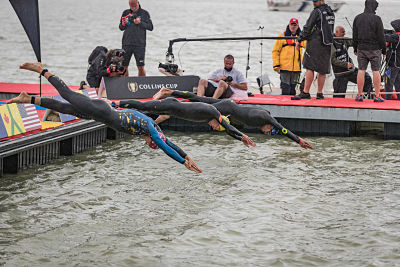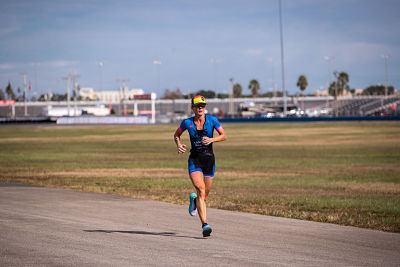The 2017 World Cross Country Championships held in Uganda were about as far from optimal race conditions as you can get. Female athletes in the under 20’s race were hauled away on stretchers and in the men’s event, Joshua Cheptegei went from enjoying a 12-second lead to staggering around the course as the extreme heat took its toll.
As the saying goes, ‘Mother Nature can be a cruel mistress’. But she can also provide conditions that help you produce your very best.
So, what do those conditions look like exactly?
How to find the optimal conditions for cycling
Cycling is a perfect example of the tug of war that can occur between environmental conditions and physiological circumstances. There’s a long and interesting formula which dictates the physics that control a cyclist’s performance. One of the factors within this formula is that of air density. If the air is less dense, then the level of resistance the cyclist is faced with reduces, and they would then go faster for the same effort as a result.
For example, there’s a choice between thicker or thinner air for athletes that compete for the cycling hour record. The record is essentially a simple one – how far can you ride in an hour whilst performing laps of a velodrome?
Riders attempting to break the record effectively have two choices when it comes to air density: stay at sea level and produce your best power output or go high up and enjoy the benefits of less dense air.
When arguably the greatest ever cyclist, Eddy Merckx, set the record in Mexico City in 1972, he competed at the almost insane altitude of 2,300m.
Merckx – nicknamed ‘the cannibal’ (due to his insatiable appetite for winning races) - decided to go all in and try and break the obscure 10km and 20km distance records at the same time. As a result, things then came unglued around the halfway point and whilst he held on to take the records, he later stated the effort took years off his life.
For the mere mortals amongst us, atmospheric pressure is still crucial - even at our local triathlon or time trial. Our best conditions would involve the phenomena colloquially known as a ‘float day’ whereby the environmental conditions are ‘perfect’.

In reality, these fastest days are those that have a low air pressure with a reasonably high air temperature and humidity. This has really only happened to me once or twice and one of those rides was memorable in my mind because I distinctly recall overtaking a car towing a caravan with a dog inside that was going nuts at his owner – probably due to the shame of it all.
Ultimately, whilst you can’t control the weather, if you’re the kind of rider who goes out to break KOM’s on Strava, it’s worth consulting the forecast beforehand to check when the air pressure is likely to be lowest, the temperature warmest and the wind will be behind you most of the time.
How does water temperature affect swimming?
Moving onto swimming, I was asked a few years ago what would happen to world records when the full body swimsuits were outlawed. These suits started to appear in the late 90’s and then dominated in the early noughties. It took nearly 10 years for the sport to then ban the things (which is about as long as it takes me to put one on) and it wasn’t funny for those left to try and break world records without the advantages that their predecessors had.
I replied that the obvious way was that if you couldn’t change the athlete, the next best thing was to change the environment the athlete competes in to make it more conducive to performance.
This was actually already happening - we have what are known as ‘fast pools’ for swimming. The swimming pool used at the Sydney Olympic Games in 2000 was actually designed as a ‘pool within a pool’ and was gutterless so that the water intentionally spilled over the edges to stop wave reflection and refraction.

As a swimmer, there are some other factors you may wish to consider when it comes to water temperature.
Firstly, dehydration can still be an issue – even when you’re exercising in water. As you’d probably expect, when water temperature rises, the risk of dehydration also increases. This might not be a big deal if you’re racing a flat 100m crawl but if you’re doing a longer open water affair or a day’s full swim meet, some hydration considerations are sensible.
Going in the other direction, swimming performance has been shown to degrade as the water gets colder because it demands more oxygen uptake to perform, which results in a less efficient swim technique. It’s why there are boundaries for how hot or cold the swim leg of a triathlon should be held in.
A scientific study in 2018 tried to articulate this point by saying an event should be held in water no cooler than 12°C (53.6°F) with a wetsuit and 16°C (60.8°F) without. There are a quite a few studies of fish out there that state water density actually drops slightly with cooler waters. You’d think this would be desirable to athletes, but you then end up with the situation the researchers in the 2018 study found when two of their participants fully committed to the pursuit of scientific truth by then developing hypothermia. This emphasises the fact that you can’t decouple the benefits of the environment from the biology of humans when you haven’t enjoyed the advantages a few million years of evolution, like our friends the salmon.
The reality is that the optimal temperature is the overall balance between what temperature you’re experiencing, your projected workout intensity and any clothing you’re wearing.
In the case of a triathlon, the differences in wetsuit thickness and coverage, as well as the size and fat percentage of the different athletes will mean the optimum water temperature will vary and this is worth testing in the days before your open water swim-based event.
Can runners learn anything from INEOS 1:59?
Finally, if we head back to where this piece started with respect to running, things get quite interesting because the environmental conditions a distance runner requires aren’t the same as those preferred by a 100m sprinter. A sprinter would want low air density, coupled with warm air and humidity. Furthermore, hotter conditions have also been demonstrated to improve the maximal peak force generated by the muscles, which would be key for sprinting.
For distance runners, their velocity is lower, so aerodynamic drag isn’t proportionally as important to their performance. Don’t get me wrong, it still matters to a point – such considerations were key in Eliud Kipchoge’s sub-2 hour marathon at the INEOS 1:59 Challenge in 2019. However, other issues such as fueling, hydration and footwear design are going to have a much greater impact on the outcome.

Then there’s the impact of the heat over longer periods of time. When the performances of the six big marathon races (such as London, Paris and Boston) were once analysed over a decade, it was shown that the greatest environmental impact on their running performance was actually air temperature and once it increased above an optimal level, performance markedly decreased. Of course, a little caution is advised as the results could have been affected by runner’s personal motivations or how in-race tactics played out.
Any heat stress – particularly those shown to be in the 25-45°C (77-113°F) range - is going to lead to the body struggling to manage itself. This will ultimately lead to a reduced performance compared to efforts in cooler events held at 15-25°C (59°-77°F). In the main though, the optimum air temperature has been suggested as being in the range of 7–15°C (44-59°F) for a marathon.
All in all, the optimum environmental conditions for your chosen event will ultimately vary based on your ability, size, duration, and location. So, it’s what I’d call a ‘Goldilocks’ scenario – not too much, not too little, and with sensitivity to your personal needs.
Either way, the best thing you can do practically is your homework in advance of what you’re likely to face and then equip and prepare yourself accordingly.
